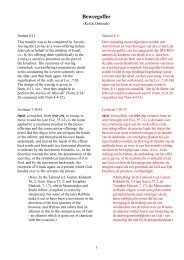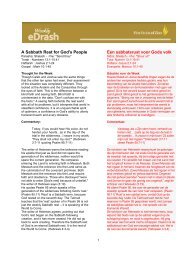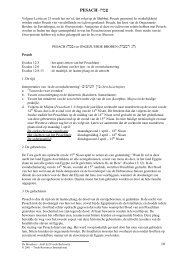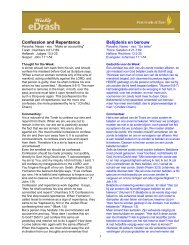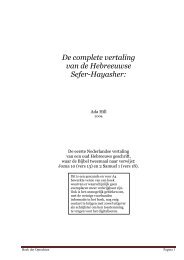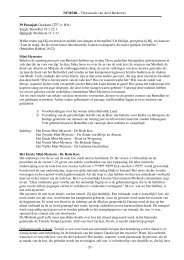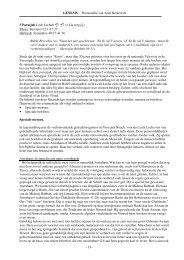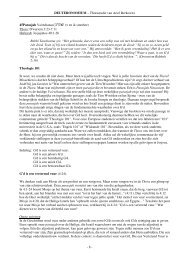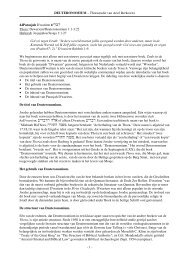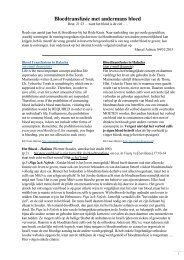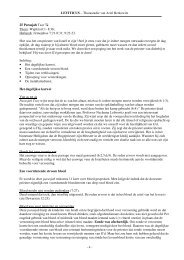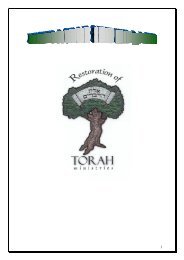Chukat verhoogd op een wonder - Messiaans het levend water
Chukat verhoogd op een wonder - Messiaans het levend water
Chukat verhoogd op een wonder - Messiaans het levend water
You also want an ePaper? Increase the reach of your titles
YUMPU automatically turns print PDFs into web optimized ePapers that Google loves.
Lifted on a Miracle<br />
Parasha: <strong>Chukat</strong> - תקח:<br />
"Statute"<br />
Torah : Numbers 19:1-22:1<br />
Haftarah : Judges 11:1-33<br />
Gospel : Matthew 21:1-17<br />
Thought for the Week:<br />
Does the serpent [set on the standard] have the<br />
power to kill or to give life? No. But so long as the<br />
Israelites lifted their eyes upward and submitted to<br />
their Father in Heaven, they were healed. If they did<br />
not, they would waste away. (m.Rosh Hashanah 3:8)<br />
Commentary:<br />
And Moses made a bronze serpent and set it<br />
on the standard; and it came about, that if a<br />
serpent bit any man, when he looked to the<br />
bronze serpent, he lived. (Numbers 21:9)<br />
When Yeshua says, "As Moses lifted up the serpent<br />
in the wilderness, even so must the Son of Man be<br />
lifted up" (John 3:14), He was hinting about the kind<br />
of death He was going to die, but there is a second<br />
meaning to these words as well. He was speaking<br />
not only of His death, but also of His ascension forty<br />
days after the resurrection.<br />
God told Moses to "make a fiery serpent, and set it<br />
on a standard." (Numbers 21:8) A standard is a pole<br />
at<strong>op</strong> which an emblem is displayed. The Hebrew<br />
word translated as "standard" (nes, סנ) is the same<br />
word often translated as "miracle." Henceforth, one<br />
might translate the passage to read, "Make a fiery<br />
serpent, and set it on a miracle." By reading nes as<br />
"miracle" instead of "standard," the Sages of the<br />
Midrash explained that Moses set the serpent on a<br />
miracle by tossing it into the air where it stayed<br />
hovering above the ground so that all Israel could<br />
look upon it:<br />
"And Moses made a bronze serpent and put it on the<br />
miracle ( סנ,<br />
nes)." That means he cast it into the air<br />
and it stayed there. (Numbers Rabbah 19.23, quoting<br />
Numbers 21:9)<br />
The literal Torah does not imply that the serpent<br />
actually levitated in the air. It is a fanciful reading, but<br />
this fanciful reading fits very well with the Master's<br />
words in John 3. Yeshua was explaining to Nicodemus<br />
that the Son of Man must be "lifted up." He had<br />
just told Nicodemus, "No one has ascended into<br />
heaven, but He who descended from heaven: the<br />
Son of Man" (John 3:13). Then He says, "As Moses<br />
lifted up the serpent in the wilderness, even so must<br />
the Son of Man be lifted up." (John 3:14) In this<br />
context, the primary meaning of His words seems to<br />
1<br />
Verhoogd <strong>op</strong> <strong>een</strong> <strong>wonder</strong><br />
Sidra: <strong>Chukat</strong> - תקח: "Statuut"<br />
Tora: Numeri 19:1-22:1<br />
Haftara: Rechters 11:1-33<br />
Evangelie: Matteüs 21:1-17<br />
Gedachte voor de Week:<br />
Heeft de slang [<strong>op</strong> de standaard geplaatst] de macht om<br />
te doden of leven te geven? Nee, maar zolang de Israë<br />
lieten hun ogen omhoog richtten en aan hun Vader in de<br />
hemel onderwierpen, werden ze genezen. Als ze dat niet<br />
deden, zouden ze wegkwijnen. (m.Rosh Hasjana 3:8)<br />
Commentaar:<br />
En Mozes maakte <strong>een</strong> k<strong>op</strong>eren slang en zette<br />
deze <strong>op</strong> de standaard; en <strong>het</strong> gebeurde, dat als<br />
<strong>een</strong> slang iemand beet, hij leefde als hij naar de<br />
k<strong>op</strong>eren slang keek. (Numeri 21:9)<br />
Als Yeshua zegt: "Zoals Mozes de slang in de woestijn<br />
<strong>op</strong>hief, evenzo moet de Zoon des mensen <strong>verhoogd</strong><br />
worden" (Johannes 3:14). Hij liet doorschemeren over<br />
<strong>het</strong> soort dood dat Hij zou sterven, maar er is ook <strong>een</strong><br />
tweede betekenis van deze woorden. Hij sprak niet<br />
all<strong>een</strong> van Zijn dood, maar ook van Zijn hemelvaart,<br />
veertig dagen na de <strong>op</strong>standing.<br />
God zei tegen Mozes van "<strong>een</strong> vurige slang te maken, en<br />
die <strong>op</strong> <strong>een</strong> standaard te zetten." (Numeri 21:8) Een<br />
standaard is <strong>een</strong> paal met bovenaan <strong>een</strong> embleem. Het<br />
Hebreeuwse woord dat als "standaard" vertaald is (nes,<br />
סנ) is <strong>het</strong>zelfde woord dat vaak met "<strong>wonder</strong>" vertaald is.<br />
Vandaar zou men de passage als volgt kunnen vertalen:<br />
"Maak <strong>een</strong> vurige slang, en zet die <strong>op</strong> <strong>een</strong> <strong>wonder</strong> ." Door<br />
nes als "<strong>wonder</strong>" te lezen in plaats van "standaard",<br />
legden de Wijzen van de Midrash uit dat Mozes de slang<br />
<strong>op</strong> <strong>een</strong> <strong>wonder</strong> zette door die in de lucht te gooien waar<br />
ze boven de grond bleef zweven, zodat gans Israel ernaar<br />
zou kunnen kijken:<br />
"En Mozes maakte <strong>een</strong> bronzen slang en zette die <strong>op</strong> <strong>het</strong><br />
<strong>wonder</strong> (סנ, nes)." Dat betekent dat hij ze in de lucht<br />
wierp en ze daar bleef. (Numeri Rabba 19,23, onder<br />
vermelding van Numeri 21:9)<br />
De letterlijke Torah leert niet dat de slang echt in de lucht<br />
zweefde. Het is <strong>een</strong> fantaserend lezen, maar dit<br />
fantaserend lezen past heel goed met woorden van de<br />
Meester in Johannes 3. Yeshua was Nicodemus aan <strong>het</strong><br />
uitleggen dat de Zoon des mensen moet worden<br />
"<strong>verhoogd</strong>". Hij had Nicodemus net verteld, "En niemand<br />
is <strong>op</strong>gevaren naar de hemel dan Hij die uit de hemel<br />
neerdaalde: de Zoon des mensen" (Johannes 3:13). Dan<br />
zegt Hij: "Zoals Mozes de slang in de woestijn <strong>op</strong>hief, zo<br />
moet ook de Zoon des mensen <strong>verhoogd</strong> worden."<br />
(Johannes 3:14) In dit context lijkt de hoofdbetekenis van
point toward His ascension. It is the ascension of<br />
Yeshua — His return to His former station of glory<br />
with the Father — that holds the promise of salvation<br />
for everyone who believes.<br />
When Yeshua ascended, He rose from the ground on<br />
the strength of a miracle. He was lifted up on a nes.<br />
Just as Moses supposedly tossed the serpent into<br />
the air and there it remained for all to look unto for<br />
salvation, so too the Son of Man has ascended and<br />
remains "lifted up" for the salvation of all who will look<br />
to Him.<br />
Therefore, Yeshua refers to both the cross and His<br />
ascension when He says, "As Moses lifted up the<br />
serpent in the wilderness, even so must the Son of<br />
Man be lifted up." (John 3:14) The lifting of the Son of<br />
Man upon the pole (nes) is the means by which the<br />
lifting of the Son of Man through the miracle (nes) of<br />
the ascension occurred.<br />
© 2011 First Fruits of Zion, Inc. | All Rights Reserved<br />
Printed from: http://ffoz.org/resources/edrash/chukat/lifted_on_a_miracle.php<br />
2<br />
zijn woorden in de richting van Zijn hemelvaart te wijzen.<br />
Het is de hemelvaart van Yeshua — Zijn terugkeer naar<br />
zijn vroegere status van glorie bij de Vader — dat de<br />
belofte van redding inhoudt voor <strong>een</strong> ieder die gelooft.<br />
Toen Yeshua <strong>op</strong>steeg, stond Hij <strong>op</strong> uit de grond met de<br />
kracht van <strong>een</strong> <strong>wonder</strong>. Hij werd <strong>op</strong>getild <strong>op</strong> <strong>een</strong> nes. Net<br />
zoals Mozes vermoedelijk de slang in de lucht gooide en<br />
ze daar voor ieder<strong>een</strong> bleef om naar te kijken voor<br />
redding, zo is ook de Zoon des mensen <strong>op</strong>gevaren en<br />
blijft "<strong>verhoogd</strong>" voor <strong>het</strong> heil van allen, die naar Hem<br />
zullen kijken.<br />
Daarom verwijst Yeshua naar zowel <strong>het</strong> kruis als Zijn<br />
hemelvaart, wanneer Hij zegt: "Zoals Mozes de slang in<br />
de woestijn <strong>verhoogd</strong>e, zo moet ook de Zoon des mensen<br />
<strong>verhoogd</strong> worden." (Johannes 3:14) De verhoging van de<br />
Zoon des mensen <strong>op</strong> de paal (nes) is <strong>het</strong> middel<br />
waarmee de <strong>op</strong>heffing van de Zoon des mensen door<br />
middel van <strong>het</strong> <strong>wonder</strong> (nes) van de hemelvaart zich heeft<br />
voorgedaan.



